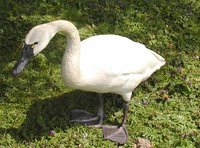Tundra Swans
|
|
| Tundra Swan Conservation status: Secure | ||||||||||||||
|---|---|---|---|---|---|---|---|---|---|---|---|---|---|---|
 Whistling Swan | ||||||||||||||
| Scientific classification | ||||||||||||||
| ||||||||||||||
| Binomial name | ||||||||||||||
| Cygnus columbianus (Ord, 1815) |
The Tundra Swan (Cygnus columbianus) is a small Northern Hemisphere swan. It has two races, which are sometimes considered to be separate species.
The Whistling Swan (C. c. columbianus) is the nominate North American form, and the Bewick's Swan (C. c. bewickii) is the European subspecies. The latter is named after the engraver Thomas Bewick, who specialised in illustrations of birds and animals.
Bewick's Swan
Bewick's is the smallest of the three European swans, at 115-127cm length and a 170-195cm wingspan. It similar in appearance to the Whooper Swan, but smaller, shorter-necked and with a more rounded head shape, with variable bill pattern, but always showing more black than yellow (the other way round with Whooper Swans). The bill pattern for every bird is unique, and scientists make detailed drawings of each and give them names to assist with studying this species.
Their breeding habitat is wetland. They pair for life, and their cygnets stay with them all winter; they are sometimes joined by offspring from previous years.
Bewick's Swans breed in the Arctic, right across northern Russia from the Kola Peninsula east to the Pacific. They migrate via the White Sea, Estonia, the Elbe estuary to the Netherlands and Britain.
Missing image Bewicks.swan.2.arp.750pix.jpg Bewick's Swan |
Missing image Bewicks.swan.slimbridge.arp.jpg Bewick’s Swan |
Populations breeding in eastern Russia (roughly east of the Taimyr Peninsula) winter in Japan and China; these are sometimes separated as the race C. c. jankowski, but this is not widely accepted as distinct, most authors including them in C. c. bewickii.
They overwinter in England and Ireland, especially in the wildfowl reserves of the Royal Society for the Protection of Birds and of the Wildfowl and Wetlands Trust.
These birds feed mainly by grazing on farmland. They have a high pitched honking call.
Whistling Swan
The American form of Tundra Swan breeds in arctic Alaska and Canada and winters in the coastal USA. It is distinguished from Bewick's by its largely black bill with a small yellow spot of variable size at the base.
The name "Whistling Swan" comes from the sound made by its large powerful wings when this bird is in flight. This bird's call is softer and less brassy than that of the Trumpeter Swan.
The female bird lays 4 to 7 eggs in a mound of plant material on a site near open water. The pair build the nest and defend a large territory around it.
In summer, their diet consists mainly of aquatic vegetation, eaten while swimming. At other times of year, they also eat cultivated grains in open fields.
Healthy adult birds have few natural predators. Although numbers are stable, they are increasingly dependent on agricultural crops to supplement their winter diet due to loss of aquatic vegetation in their winter habitat as a result of habitat destruction and water pollution.
